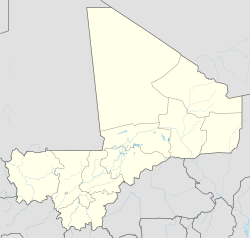Kayes
Kayes
Kayi, Xaayi | |
|---|---|
Commune and city | |
 Men cross a busy street in Kayes, 2006. | |
Location within Mali | |
| Coordinates: 14°27′N 11°26′W / 14.450°N 11.433°W | |
| Country | |
| Region | Kayes |
| Cercle | Kayes Cercle |
| Town founded | 1880s |
| Elevation | 33 m (108 ft) |
| Population (2009 census)[1] | |
| • Total | 127,368 |
| Time zone | UTC+0 (GMT) |
Kayes (Bambara: ߞߊߦߌ tr. Kayi, Soninké: Xaayi) is a city in western Mali on the Sénégal River with a population of 127,368 at the 2009 census. Kayes is the capital of the administrative region of the same name. The name "Kayes" comes from the Soninké word "karré", which describes a low humid place that floods in rainy season. The city is located 420 kilometres (260 mi) northwest of the capital Bamako.
History
Prior to French colonial expansion, Kayes was a small village. Its location on the path of the future Dakar-Niger Railway, and the French need for trade centers, led to the creation of the Kayes market town in 1881. It remains a transport hub, primarily for Senegalese trade, to this day. In 1892, Kayes became the capital of the French Sudan; Bamako replaced it as the capital, first of the state of Haut Sénégal-Niger on October 17, 1899, then as the capital of all of French Sudan in 1908.
Economy and transport
Kayes lies on the Route Nationale 1 (RN1) highway and is 612 km (380 mi) by road from Bamako and 96 km (60 mi) from the border with Senegal. The town has an international airport (Kayes Airport), and lies on the Dakar-Niger Railway which offered regional passenger train service to Bamako three times a week via Kati and Diamou as of 2013.[2] The area is rich in gold and iron.
Climate
Kayes has a hot semi-arid climate (Köppen climate classification BSh). The climate is subject to the West African Monsoon with all the rainfall occurring between June and October. August is the wettest month. There is almost no rainfall during the other seven months of the year. The total annual rainfall is around 650 millimetres or 26 inches.[3] Kayes is nicknamed the "pressure cooker of Africa" due to its extreme heat; the town is surrounded by iron-rich mountains which contribute to the temperature. The town has been described as the hottest continuously inhabited town in Africa.[citation needed] The average daily high temperature in the city is 36.4 °C (97.5 °F), with temperatures usually peaking in April and May at an average of nearly 42 °C (108 °F).[4]
| Climate data for Kayes (1950-2000) | |||||||||||||
|---|---|---|---|---|---|---|---|---|---|---|---|---|---|
| Month | Jan | Feb | Mar | Apr | May | Jun | Jul | Aug | Sep | Oct | Nov | Dec | Year |
| Mean daily maximum °C (°F) | 33.6 (92.5) |
36.6 (97.9) |
39.4 (102.9) |
41.7 (107.1) |
41.9 (107.4) |
38.2 (100.8) |
33.6 (92.5) |
32.0 (89.6) |
33.1 (91.6) |
36.1 (97.0) |
36.7 (98.1) |
33.5 (92.3) |
36.4 (97.5) |
| Mean daily minimum °C (°F) | 16.9 (62.4) |
19.3 (66.7) |
22.2 (72.0) |
25.5 (77.9) |
28.4 (83.1) |
26.6 (79.9) |
24.2 (75.6) |
23.3 (73.9) |
23.2 (73.8) |
23.0 (73.4) |
20.0 (68.0) |
17.2 (63.0) |
22.5 (72.5) |
| Average rainfall mm (inches) | 0.0 (0.0) |
0.4 (0.02) |
0.1 (0.00) |
0.6 (0.02) |
12.0 (0.47) |
82.6 (3.25) |
155.2 (6.11) |
215.9 (8.50) |
140.9 (5.55) |
41.2 (1.62) |
2.7 (0.11) |
1.1 (0.04) |
652.7 (25.69) |
| Average rainy days (≥ 0.1 mm) | 0.0 | 0.0 | 0.1 | 0.1 | 2.8 | 7.8 | 12.3 | 14.8 | 11.4 | 4.0 | 0.1 | 0.0 | 53.4 |
| Mean monthly sunshine hours | 263.5 | 250.0 | 282.1 | 285.0 | 279.0 | 215.0 | 211.8 | 223.2 | 240.0 | 263.5 | 264.0 | 260.6 | 3,037.7 |
| Source 1: World Meteorological Organization[5] | |||||||||||||
| Source 2: NOAA (sun 1961–1990)[6] | |||||||||||||
Area
Sites found in and around Kayes include:
- Fort du Médine
- Félou Falls, 15 km (9.3 mi) upstream on the Senegal river
- Gouina Falls, 100 km (62 mi) to the southeast on the Senegal river
- The tata (fortification) of Koniakari, constructed by El Hadj Umar Tall, 70 km (43 mi) to the northeast
- Lake Magui and Lake Doro, both watered by the Kolimbiné River
- The Manantali Dam

See also
References
- ^ Resultats Provisoires RGPH 2009 (Région de Kayes) (PDF) (in French), République de Mali: Institut National de la Statistique, archived from the original (PDF) on 2012-07-27.
- ^ Mali Seat 61, http://www.seat61.com/Senegal.htm#.U2JXgMfEc7A
- ^ Weather Information for Kayes, World Weather Information Service, retrieved 15 May 2012
- ^ Cornet, Pierre (1956). "Sahara, terre de demain".
- ^ "World Weather Information Service – Kayes". World Meteorological Organization. Retrieved 12 October 2015.
- ^ "Kayes Climate Normals 1961–1990". National Oceanic and Atmospheric Administration. Retrieved 12 October 2015.
- Portions of this article are a translation of French language Wikipedia's Kayes.
External links
- Colonial history of Kayes, from Web Site of Dr. Jim Jones, "African History Since 1875", West Chester University Department of History.
- View of Sénégal River Bridge at Kayes: Kidira Border Crossing into Mali, December 16, 2004 by NKOverland.


